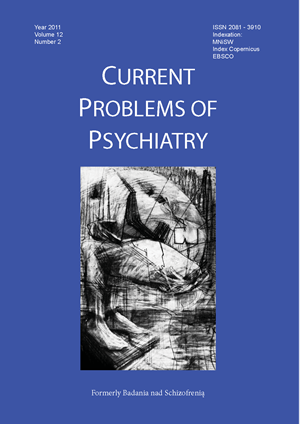The therapeutical and psychiatric aspects of musical-dancing trance rituals in the chosen traditional cultures
Keywords:
ethnopsychiatry, traditional dancesAbstract
Trance is a medical term contained in Chapter V of International Statistical Classification of Diseases and Related Health Problems (ICD-10) together with possession and denotes disorder characterised by transitional loss of own identity and decline of complete understanding of the surroundings.
In this article I want to deal only with some of the known to me phenomena of trance, dependent on will, determined by culture and religion in Christianity, Islam and Judaism.
Tarantism is a religious-cultural phenomenon with medieval roots still preserved in the south Italy. It was connected with a indigenous tribes’ belief that a bite of tarantula (wolf spider), common in the area, causes a particular change of behaviour of stung people. Tarantella is a folk dance which has a really pronounced trance character with a stimulated by obsessive sound of small drum – tambourine rhythm and with a participation of an instrument playing the melody.
Sufism is a faction of mystical movement grown on the basis of Islam and reaching with its roots to the 13th century, when lived and worked the spiritual founder of the idea of the Whirling dervishes’ order Jalāl adDīn Muḥammad Rūmī-Mowlānā . The dance of dervishes accompanying the ceremony known as the Sema belongs to the group of ritual dances and can be treated symbolically as the expression of what is mystical amongst earthly creatures. The aim of the dance is not to introduce oneself only into a state of ecstasy but to achieve the state of connectivity with merits and spiritual gifts from God to people.
Jewish religious ceremonial abounds with rites in which gestures and dance have a huge importance, especially in Hasidism, the mystical branch of Judaism. Joyful festive feasts, singing and dancing were accounted as the most important elements of the service to God. Dances lasted till the reaching the state of ecstasy, what was supported by the talles put on the eyes and whirling in different directions.
Phenomena of trances and ecstasy, which are frequently identified with each other, were named by the researchers of the subject as changed states of conscience and meant particular states caused by physiological or psychological factors, which are characterised by the deviation in subjective understanding of the reality and the change towards the approved forms of behaviour during experiencing them. Musical-dancing trance rituals are perceived as the elements of the phenomenon of Catharsis, in close connection with a religious context.
References
1. Międzynarodowa Statystyczna Klasyfikacja Chorób i Problemów Zdrowotnych, rewizja dziesiąta, rozdział V. Kraków: Uniwersyteckie Wydawnictwo Medyczne „Versalius”; 1994.
2. Kaplan H.I., Sadock B.J., Sadock V.A. Psychiatria kliniczna, Wrocław: WM Urban i Partner; 2004.
3. Jesteśmy nieokrzesani. Rozmowa z prof. Leszkiem Kolankiewiczem. Czas Kultury, 2004; 2-3.
4. Żmidziński J. Muzyka rytuału, Czas Kultury, 2004; 2-3.
5. Welcz H. Analiza psychoterapeutycznego znaczenia zjawiska rytuałów muzyczno-tanecznych na przykładzie praktyk tarantyzmu z południowych Włoch. Bad. Schizofr., 2007.
6. Zielińska J. Ścieżka do Boga. O tańcu zakonu wirujących derwiszów. Didaskalia, 2008; 85/86: VI-VIII.
7. Łumiński J. Tańce i obrzędy żydowskie. Akcent, 1987; 3.
8. Kokoszka A. Poznawcze, fizjologiczne i psychoterapeutyczne aspekty „zmienionych stanów świadomości”. Psychoterapia, 1982; XLII.
9. Zimbardo Ph. Psychologia i Życie. Warszawa: PWN; 1988.
Downloads
Published
Issue
Section
License
Copyright (c) 2011 Authors

This work is licensed under a Creative Commons Attribution-NonCommercial-NoDerivatives 3.0 Unported License.


